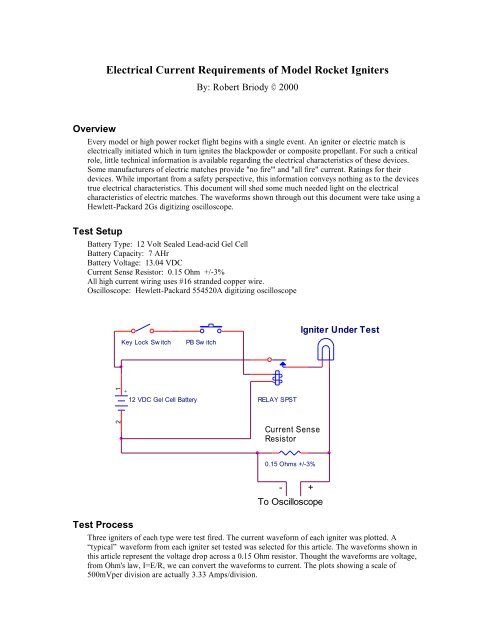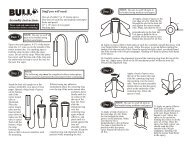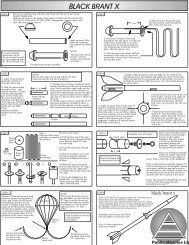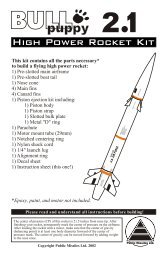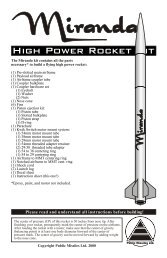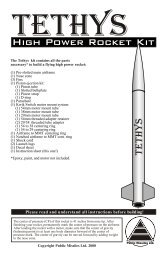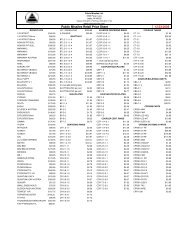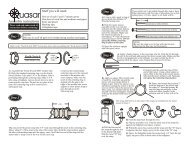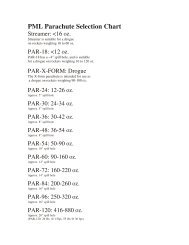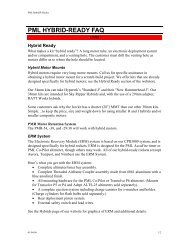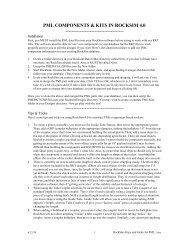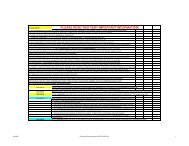Electrical Current Requirements of Model Rocket Igniters
Electrical Current Requirements of Model Rocket Igniters
Electrical Current Requirements of Model Rocket Igniters
You also want an ePaper? Increase the reach of your titles
YUMPU automatically turns print PDFs into web optimized ePapers that Google loves.
Shown in Figure 10 is a hybrid igniter. The bridge heating element is formed using IgniterMan'sConductive Primer. The pyrogen used is Magnelite.Figure 10. IgniterMan bridge element with Magnelite pyrogen. The scale is 3.33 amps/div. Peakcurrent is 18.85 amps.Figure 11 shows the current draw <strong>of</strong> a standard Estes igniter when connected to a 12 VDC lead-acidbattery.Figure 11. Estes standard model rocket igniter. The scale is 3.33 amps/div. Peak current is 12.39amps.
Figure 12 shows the current draw <strong>of</strong> a standard Estes igniter when augmented with IgniterManPyrogen. Again, the igniter is connected to a 12 VDC lead-acid battery.Figure 12. Estes standard model rocket igniter augmented with IgniterMan Pyrogen. The scaleis 3.33 amps/div. Peak current is 23.33 amps. Note the high current draw <strong>of</strong> the plasma.
Electric Match Compatibility with 9 VDC BatteriesMost Altimeters and Accelerometers used for air-starting motors and recovery initiation use thestandard 9VDC transistor battery. As you'll see from the following waveforms, you'll probably want toswitch to using a dual battery system. In a dual battery system, one battery is used to power thecomputer or electronics and a second battery is used to power electric matches and the associated firingcircuitry. The battery grounds are common but the Plus (+) terminal are separate and isolated. Thisconfiguration prevents power spikes or glitches, produced by firing electric matches, from causingerratic or erroneous flight computer or timer operation.Figure 13 shows what happens when a DaveyFire N28F is placed directly across the terminals <strong>of</strong> aStandard Duracell Copper Top 9VDC alkaline battery. The battery is fresh with an open circuit voltage<strong>of</strong> 9.68 VDC. The current demands <strong>of</strong> the electric match are such the battery voltage dips to 2.56VDC! This has serious potential for glitching or causing anomalous behavior for most ANY flightcomputers on the market.Figure 13. Terminal voltage <strong>of</strong> a 9 VDC Duracell battery with a DaveyFire N28F across theterminals.
Figure 14 shows a DaveyFire N28F across the terminal <strong>of</strong> a Duracell ULTRA 9VDC transistorbattery. Though the results were improved, there is little to no room for electric match variance.Figure 14. Battery voltage <strong>of</strong> a Duracell ULTRA with a DaveyFire N28F connected directly toit. The cell voltage drops to 5.37 VDC from 9.59 VDC.In the next test I connect a DaveyFire N28B (white wire) directly across the terminals <strong>of</strong> a DuracellCopper Top 9VDC transistor battery. Figure 15 shows the superior electrical performance <strong>of</strong> the N28Bover the N28F. This electric match requires the least amount <strong>of</strong> current and is excellent for recoveryinitiation. WARNING: The N28B is incapable <strong>of</strong> reliably firing composite propellant motors. It's burntemperature is too low and burn rate too fast. Reliable motor ignition is best achieved through Firestar,IgniterMan, Magnelite or dipped/augmented Daveyfire N28F igniters.Figure 15. DaveyFire N28B across Duracell Copper Top or ULTRA battery. The batteryvoltage was within 0.2 VDC for both batteries in this test. The waveforms were also nearlyidentical.
Last, we test the loading effects <strong>of</strong> a Robby's <strong>Rocket</strong>s AG-1 Flashbulb-based ejection charge on a Duracell9 VDC battery. The results are shown in figure 15. Notice how the voltage dips instantaneously from 9.65VDC to 4.312 VDC. Depend on the avionics, this low voltage could cause anomalous behavior in somesystems.Figure 15. Robby's <strong>Rocket</strong>s AG-1 flashbulb-based ejection charge across a Duracell CopperTop. Note the battery voltage momentarily dips to 4.31 VDC, down from 9.65 VDC.
SummaryIgniter/electric match electrical current demands vary widely, as can be seen from the aboveinformation. The above waveforms must not be considered “worst case” as I have no manufacturingprocess information from any <strong>of</strong> the manufacturers. As only three igniters or electric matches weretested from each manufacturer, the tests results are only a ‘snap shot in time’.The “all fire / no fire” current ratings, though useful, don’t adequately show the igniters true electricalcharacteristics. When choosing an electric match, you must understand the target application. Ifconnected to computer-controlled electronics or digital logic, you must design the system to handle thePEAK current demand <strong>of</strong> the igniter/match. Failure to perform either one <strong>of</strong> these steps can causeserious malfunction or momentary failure <strong>of</strong> the electronics. This could cause your prized rocket to“lawn dart” or “core sample”. Remember, this is rocket SCIENCE.AcknowledgmentsThank you Doug Pratt <strong>of</strong> Pratt Hobbies for providing the DaveyFire N28B electric matches withoutcharge for this test. Thank you Pius Morozumi for providing several varieties <strong>of</strong> electric matches,flashbulbs and for convincing me to expand the scope <strong>of</strong> this document to include nearly all <strong>of</strong> thecommon igniters used in model and high power rocketry. Thanks also goes to my son, Scott Briody,for helping me perform the tests.


